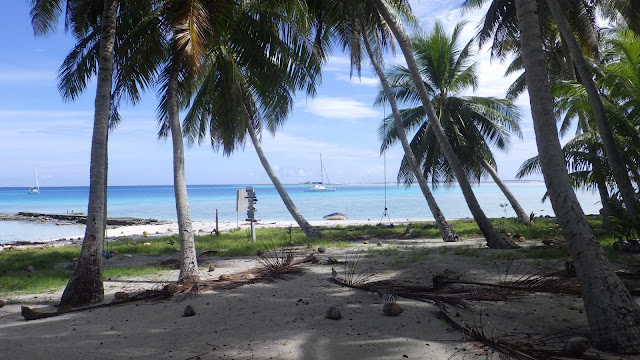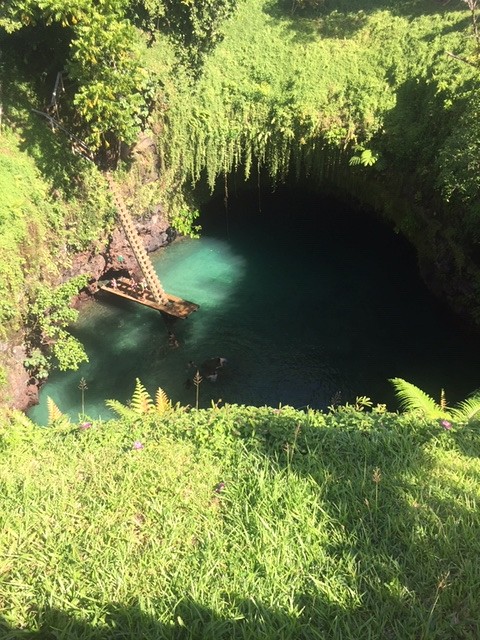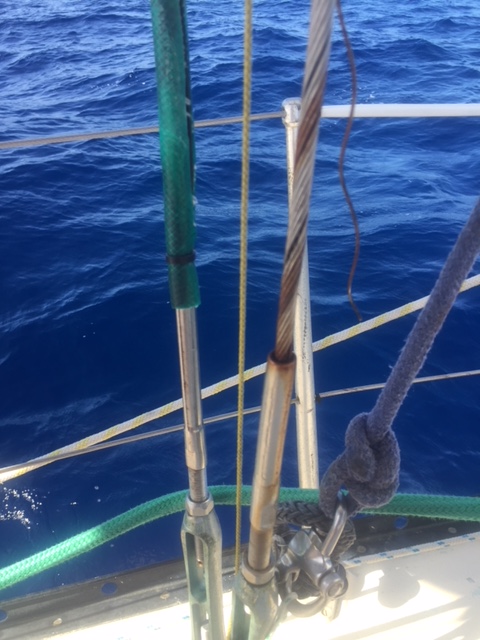January 29th, 2019, Pacific Ocean
 |
| Lifetime Panama Canal Ship ID for Shanti |
Yet again, plans are as fluid as water. A few moments before
my volunteer linehandlers arrived, the agent appeared on the dock to tell me my transit
had been rescheduled for the following day.
At first this seemed a low blow, but good came of it, providing a day
off, to relax by the pool and get to know one another.

It’s necessary to have 4 linehandlers on board and my agent
was providing two men, at $100 each. Cruisers often help each other transit just for
the experience and I found two extras through the Panama Cruisers Facebook page.
Rachel and her husband Josh have their own boat on the Pacific side of the
canal, in the newly opened Vista Mar marina. At first they were both coming,
but Josh was busy preparing their boat for the South Pacific, so we became an
“all girl” crew with the substitution of their good friend, Becca, a highly
qualified young lady with her 100 ton Captain’s licence. They both proved to be
exceptional women and great company. Another huge benefit was their willingness
to help in the galley.
The meals I had precooked moved into another boat’s freezer
(thanks Craig and Julie). The girls and I had Pina Coladas and pizzas at the
marina restaurant that evening and they got to sleep for two nights on board
Shanti instead of one.
On Thursday 24th, at midday, the two hired hands,
Leroy and Jackson arrived, and I fed everyone some lunch before heading out to
the “flats” to await our Advisor. The 60’ yacht, “Sauvage” that we were to
transit alongside was already anchored there. The next few hours were the
beginning of the waiting game. I was impressed with Leroy and Jackson’s ability
to intersperse periods of dozing with sudden springing to action.
At 1630, a large black Pilot vessel approached, looking for
all the world like it was going to plough us down, but stopped within inches to
allow our Advisor, Edward, to step nimbly aboard. They sure know how to
manoeuvre those powerful beasts incredibly skilfully; it’s almost as if the
vessels are fitted with those electronic sensors that cars have to warn when
you’re about to run over the neighbour’s dog.
Action stations! Start the engine, lift the anchor and begin
heading towards the entrance to the locks, about 7 miles away. We are scheduled
to transit the first three Gatun locks at 1800, following a very rusty looking
ship that was anchored on the other side of the channel. Edward kept us
informed of its movements (or lack thereof).
This is where confusion comes in. After gunning the engine
full tilt to cover the distance, we find ourselves stuck in a “holding pattern”
near the lock entrance for a couple of hours, just driving slowly round in
circles, while two other tankers proceed before us. Nobody knows why.
Finally we spot “our ship” coming and it’s time to raft up
(tie alongside) our buddy boat,
“Sauvage”. Her skipper approaches Shanti painfully slowly and I wish we
were doing it the other way round, with Shanti using them as the moving dock.
There are plenty of hands, and fenders, and even though one of their crew
accidentally lets our stern line slip, with much yelling, and the next monster
ship is blasting us to get out of its way, we finally proceed as one, into the
lock.
The “uplocks” are vast empty chambers, waiting to be filled
with 101,000 cubic metres, or 26.7
million gallons of fresh water to lift us about 10 metres to the next lock. The
turbulence of this rapid inflow is huge, swirling around us like rapids. It’s a
very weird sight looking back at the lights of Colon from our new height.
At 60’, “Sauvage” is big enough to take all four lines from
both sides of her bows and stern, so nothing is required of us; we will just be
dragged through like a limpet alongside.
This is where further confusion arises. Our rusty ship has a
large tugboat behind it, tied up against the starboard wall, which for some
unknown reason, we were expected to tie to. Hence there are no lines being
thrown to our port side; in other words, nothing to stop Shanti from getting
ever nearer the 30’ high concrete wall to our right. Again, much yelling,
before in the nick of time we are secured.
The system is very human dependent. Four men, looking like
little Lego men, way up high above us on the top edge of the lock throw the
“monkey fists” at us. These are heavy balls of woven twine with metal centres
that carry the thin “trace” lines, hopefully avoiding windows, hatches, solar
panels, wind generators, and people. I was glad they were primarily being aimed
at “Sauvage”, although we did have to transfer a couple that didn’t quite make
the distance.
The linehandlers on board their boat then have to speedily
tie these to the heavy 140’ dock lines they have prepared, laying them out
carefully without twists or tangles. These are thrown overboard and the Lego
men above pull them up and secure them to a bollard at the top of the
lock. The people on the boat take up the
slack, constantly monitoring the change in tension as the water rises. It’s a
demanding job. I watched a very muscle-bound woman next door frantically working
to free some tangles, as if trying to detach a determined boa constrictor.
Fortunately, the monkey fists are only thrown once for the
first of the three Gatun locks. Having risen to the top, the massive gates in
front are opened, the heavy ropes are dropped back to us and we motor through,
with the Lego men walking quickly along the wall with the trace lines in tow. All rather remarkable, and generally
proceeding smoothly, contrary to all the horror stories I heard beforehand.
After passing through the third lock, we entered Lake Gatun,
where we were to spend the night. Unusually, we remained “nested” against
“Sauvage”, who dragged us speedily through the darkness. Using powerful
rabbit-blinder torches they managed to spot one of the giant round buoys to tie
up to. The two yachts stayed snugged up together, which made for some
uncomfortable rolling and jerking as ships continued to transit the lake all
night long. Leroy and Jackson slept out in the cockpit and luckily it didn’t
rain.
Normally, there are different Advisors each day, but to our
pleasure, we had Edward again, who returned at 0830 on Friday, ready to go. He
brought a big black plastic bag full of ice to cool the dozens of bottles of
water and soft drinks that I was required to provide. Scrambled eggs and
croissants were eaten under way thanks to my wonderful female crew, who handled
that side of things fantastically.
One of my greatest stresses now faced me; could Shanti with
her small engine and extra load of 6 bods keep up in motoring across the lake?
I had deliberately avoided filling the extra jerry cans of diesel and water
tanks to keep the weight off. (Once anchored safely on the Pacific side we ran
out of water so we drank beer and rum instead.)
Our appointed ship was due to follow us into the Pedro
Miguel “downlock” at 1330, which was 30 miles away. Leaving at 0830 gave us 5
hours to get there, which meant averaging 6 knots of boat speed across the lake;
a very big ask. I was pleased to find that “Janis”, the trusty little Yanmar
was capable of around 5.7 knots, but it was not enough. I had visions of living
the rest of my days stuck in Lake Gatun. The two Advisors had already agreed
that the bigger yacht would peg back its speed and wait for us.
That didn’t happen. Quite early in the route, they passed us
and slowly pulled away. Very disheartening. Edward’s two main comments were,
“Can you go any faster?” and “Move further over to the edge of the channel.”
Neither was particularly helpful. I wasn’t prepared to risk total engine
failure for the sake of a bit more speed nor running aground on the rocks that
were within spitting distance in places.
I thought we made pretty good time, but as our ship passed
us I asked Edward if they knew they were supposed to be locking with us. His
reply was, “they don’t care.” He said we would just have to wait for another ship
to go through with. Luckily a massive car carrier was fast approaching, so
without missing a beat, we drove straight into the Pedro Miguel lock in front
of it.
We spotted our non-buddy boat, “Sauvage” in the adjacent
lock, tied alongside a small passenger ship. The girls made a few saucy comments,
but really were glad to be on red alert, ready to test their knot tying skills.
The monkey fists were thrown, the first one missed completely and landed in the
water, the next one wrapped itself several times around the stays, the next one
hit the aluminium bottom of the upturned dinghy on the foredeck with a
percussive diiinngg. One of them Rachel caught perfectly, to much cheering.
This process had to be done twice for this set of locks as
there is a longer distance between the first and second, so more monkey fist
missiles came hurtling at us, but all were fielded beautifully. Go girls!
If anything is going to go wrong, they say it will be in the
Miraflores, where the current swirls and gushes incredibly strongly, as if in a
rush to reach the Pacific. It pinned the rudder hard across, almost forcing the
tiller from my hands.
As we descended, I looked up at the sheer black walls of the
100 year old concrete sides of the lock, marvelling at the engineering of those
times and considering the enormous cost in human lives to build this mighty
canal. About 40 ships pass through every day; Edward told us it costs close to
a million US dollars per ship to transit, which made my paltry 2 grand seem
very reasonable.
Taking a moment to reflect on all this, I noticed that the
trace line from my port stern was caught on one of the bollards recessed into
the sides of the wall. The linesman above could not see this. I pointed it out
to Edward, who told me not to worry, they would free it.
So the bells ring, the massive lock gates in front of us
open, the current swirls and pushes us forward, the line handlers above release
the lines – and, sure enough, one is caught. The ship behind us begins to move
and Edward tells me to go. But how? We are still tied to the wall.
Well, I need not embellish the panic and confusion that
ensued, with Rachel telling us to take deep “Yoga breaths” and stay calm.
Easily said when about to be squished like a bug by a Goliath.
It was her line that was caught, and much as the guy on top
of the wall flicked and whipped, it stayed caught. As we moved forward, she
played out more and more of the heavy line that we still had onboard, fully
prepared to lose the whole lot if necessary, rather than see Shanti pulled back
against the wall, or worse still, run over by the ship. Of course the ship
wouldn’t be happy to tangle our rope round his prop, so it was good that she
didn’t have to.
Eventually, after what seemed like several lifetimes, the
little Lego man above had the good sense to let go of his end. It could still
have been wrapped too tightly to release, or gotten stuck with the monkey fist,
but praise all the powers that be, it slipped free, trailing in the water
behind us. Hallelujah!
Following this adrenaline spike, we were fast approaching
the gates of the final lock, with only one stern line. These are the most
important lines to hold us back, so it was a mad scramble to tie the jettisoned
line onto the bow line and send it back up to be reattached and secured. Again,
Rachel did a sterling job of this, while I had the engine in hard reverse.
As they say, it will all be alright in the end, and if it’s
not alright, it’s not the end. We managed to avoid all the hard concrete and
steel bits; nothing got broken, no one was hurt, and in the end, it was all
alright, with a story to tell.
We crossed under the iconic Bridge of Americas, and we were
in the Pacific, with its 5 – 6 metre tides!!!! So much stress and SO thrilled
to have made it.
 |
| Cheers bigears! |
With seamless precision, our trusty Advisor was picked up
shortly after, followed by a taxi boat to take the ropes, fenders, and
excellent linehandlers, Leroy and Jackson. The girls and I continued on alone
to anchor off La Playita for an “arrival survival” drink, to unwind, laugh,
chat and debrief. Then they left via the dinghy of friends anchored nearby and
caught a cab back to their own boats and husbands.
 |
| Track from the Atlantic to the Pacific |
The girls set up three GoPro cameras on board to capture the action, so I have plenty of memory joggers for my dotage.
I slept the sleep of the dead, woke early and set sail to
Vista Mar marina, to refuel, put on more water and provisions in readiness for
the next big hop. The really great thing was I arrived in time to phone my
father in NZ for his 101st birthday on the 28th January.
 |
| Vista Mar: just like being at Mackay with tall piles to handle the big tides. |
Tomorrow morning I head out into the Pacific, with a brief
stop at Las Perlas islands before the 4,000 mile crossing to Gambier Islands.
This will be the longest leg I have ever done and I’m hoping I have enough food
and water for what could be 2 – 3 months, depending on how long it takes to get
through the doldrums. So don’t expect any more blog updates for a while.
Wishing everyone all good things, with much excitement
tempered by deep tranquillity.





































